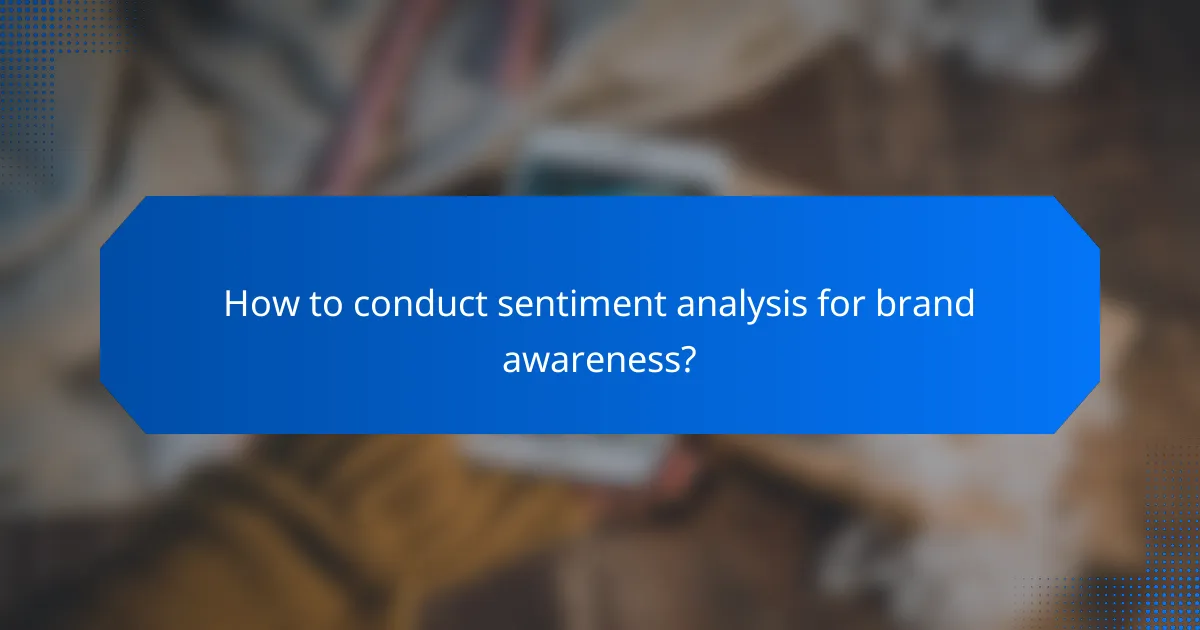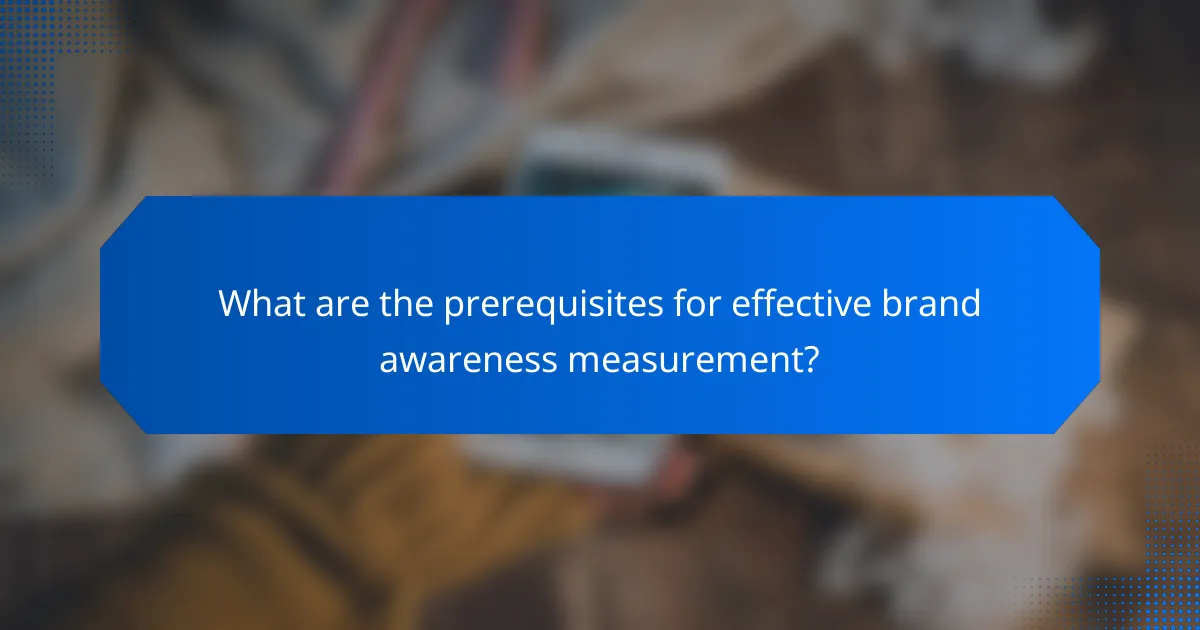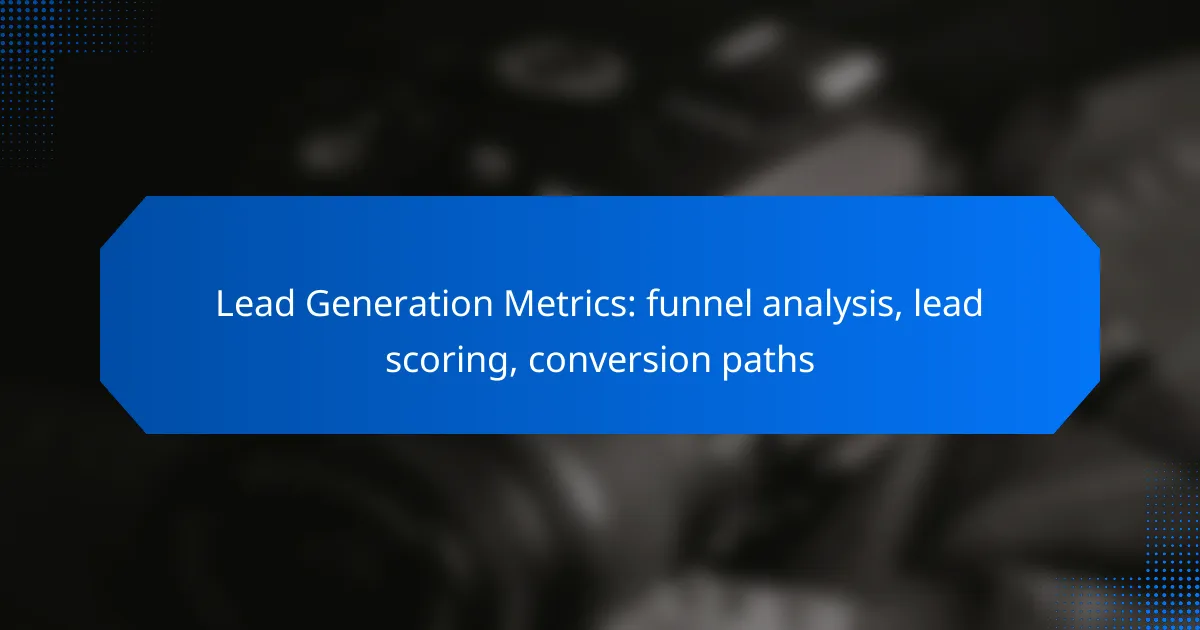
Measuring brand awareness is crucial for understanding how well your brand is recognized and perceived by the public. Key metrics such as reach, impressions, and sentiment analysis provide valuable insights into your brand’s visibility and reputation, enabling businesses to refine their marketing strategies effectively.

How to measure brand awareness in Australia?
Measuring brand awareness in Australia involves assessing various metrics that reflect how well your brand is recognized and perceived by the public. Key metrics include reach, impressions, and sentiment analysis, each providing unique insights into your brand’s visibility and reputation.
Using reach metrics
Reach metrics indicate the total number of unique individuals who have encountered your brand within a specific timeframe. This can be measured through social media analytics, website traffic, and advertising platforms, helping you understand the breadth of your audience.
To effectively use reach metrics, focus on tracking changes over time and comparing them against marketing campaigns or initiatives. A good practice is to set benchmarks based on historical data to evaluate the impact of your efforts.
Utilizing impressions data
Impressions data reflect the total number of times your brand content is displayed, regardless of whether it was clicked or engaged with. This metric is crucial for understanding how often your brand is being seen, particularly in digital advertising and social media contexts.
When analyzing impressions, consider the context in which they occur. High impression counts with low engagement may indicate that your content needs to be more compelling or better targeted. Regularly review your campaigns to optimize for both reach and engagement.
Implementing sentiment analysis
Sentiment analysis involves evaluating public perception of your brand through social media mentions, reviews, and customer feedback. This qualitative metric helps gauge whether your brand is viewed positively, negatively, or neutrally, providing deeper insights into consumer attitudes.
To implement sentiment analysis effectively, use tools that aggregate and analyze data from various platforms. Regularly monitor sentiment trends to identify potential issues or opportunities for improvement in your brand messaging and customer interactions.

What are the key brand awareness metrics?
Key brand awareness metrics include reach, impressions, and sentiment analysis, which help evaluate how well a brand is recognized and perceived by its audience. Understanding these metrics allows businesses to tailor their marketing strategies effectively.
Reach as a primary metric
Reach measures the total number of unique individuals who have been exposed to a brand’s message. It is crucial for understanding the potential audience size and the effectiveness of marketing campaigns.
To maximize reach, brands should consider using diverse channels such as social media, email marketing, and traditional advertising. Aiming for a broad reach can help in building brand recognition and attracting new customers.
Impressions for visibility tracking
Impressions indicate how many times content is displayed, regardless of whether it was clicked or engaged with. This metric helps brands assess the visibility of their marketing efforts and understand how often their messages are being seen.
While high impression counts can suggest good visibility, it’s essential to analyze them alongside engagement metrics to gauge true effectiveness. Brands should focus on creating compelling content that encourages interaction, rather than solely chasing high impression numbers.
Sentiment analysis for audience perception
Sentiment analysis evaluates the emotional tone behind online mentions of a brand, helping to understand audience perceptions. This metric can reveal whether the brand is viewed positively, negatively, or neutrally.
To conduct sentiment analysis, brands can use tools that analyze social media posts, reviews, and comments. Monitoring sentiment over time can provide insights into how marketing campaigns influence public perception and guide future strategies.

How does reach impact display advertising effectiveness?
Reach significantly influences the effectiveness of display advertising by determining how many unique users see an ad. A broader reach can lead to greater brand visibility and awareness, which are essential for driving engagement and conversions.
Increased audience exposure
Increased reach means that more potential customers are exposed to your brand’s message. This exposure can be crucial for building brand recognition and establishing a presence in the market. For instance, a campaign that reaches thousands of users can create a buzz that smaller campaigns may not achieve.
Consider using various platforms to maximize reach, such as social media, websites, and mobile apps. Each platform can target different demographics, enhancing overall audience exposure and ensuring your message resonates with diverse groups.
Higher potential engagement rates
With a larger reach, the likelihood of higher engagement rates increases. When more people see your ads, there are more opportunities for clicks, shares, and interactions. Engaging content that resonates with your audience can lead to a significant uptick in these metrics.
To optimize engagement, focus on creating compelling visuals and clear calls to action. Testing different ad formats and messages can help identify what resonates best with your audience, ultimately driving better results from your display advertising efforts.

What role do impressions play in brand awareness?
Impressions are a key metric in brand awareness, representing the total number of times an ad is displayed, regardless of whether it is clicked. They help marketers gauge how many potential customers have been exposed to their brand messaging, which is essential for building recognition and familiarity.
Tracking ad visibility
Tracking ad visibility involves measuring how often your ads are seen by users. This can be done through various analytics tools that provide insights into impression counts across different platforms. Understanding visibility helps brands assess the effectiveness of their advertising strategies and adjust them accordingly.
For example, if an ad campaign generates thousands of impressions but low engagement, it may indicate that the ad is not reaching the right audience or that the creative needs improvement. Regularly monitoring visibility ensures that brands can optimize their campaigns for better performance.
Understanding frequency of exposure
Frequency of exposure refers to how many times a single user sees an ad within a specific timeframe. This metric is crucial because repeated exposure can enhance brand recall, but too much frequency may lead to ad fatigue. Finding the right balance is essential for maximizing brand awareness without overwhelming potential customers.
A common practice is to aim for a frequency of around three to five impressions per user over a campaign’s duration. This range typically allows for effective messaging without causing annoyance. Brands should continuously analyze frequency data to ensure they are not oversaturating their audience while still achieving desired awareness levels.

How to conduct sentiment analysis for brand awareness?
Sentiment analysis for brand awareness involves evaluating public perceptions and feelings about a brand through various data sources. This process helps businesses understand how their audience views them, which can guide marketing strategies and improve customer engagement.
Using social media listening tools
Social media listening tools enable brands to monitor conversations and mentions across platforms like Twitter, Facebook, and Instagram. These tools often provide sentiment scoring, categorizing mentions as positive, negative, or neutral, which helps gauge overall brand perception.
Popular tools include Hootsuite, Brandwatch, and Sprout Social. When selecting a tool, consider factors like ease of use, integration capabilities, and the specific social networks you want to track.
Analyzing customer feedback
Customer feedback can be gathered through surveys, reviews, and direct interactions. Analyzing this feedback allows brands to identify common themes and sentiments expressed by their customers, providing insights into brand strengths and weaknesses.
Utilize platforms like Google Forms or SurveyMonkey to create surveys that ask specific questions about brand perception. Pay attention to open-ended responses, as they often reveal deeper insights into customer feelings and experiences.

What are the prerequisites for effective brand awareness measurement?
Effective brand awareness measurement requires a clear understanding of your target audience and well-defined objectives. These prerequisites ensure that the metrics you gather are relevant and actionable, allowing for meaningful insights into your brand’s visibility and perception.
Defining target audience
Defining your target audience is crucial for accurate brand awareness measurement. Start by identifying demographic factors such as age, gender, location, and interests. This information helps tailor your marketing efforts and ensures that your messaging resonates with the right people.
Consider using tools like surveys or social media analytics to gather data on your audience’s preferences and behaviors. By segmenting your audience into distinct groups, you can create more personalized campaigns that enhance engagement and brand recall.
Setting clear objectives
Setting clear objectives is essential for measuring brand awareness effectively. Define what you want to achieve, whether it’s increasing reach, improving sentiment, or boosting impressions. Specific goals, such as increasing social media followers by a certain percentage within a set timeframe, provide a benchmark for success.
Ensure that your objectives are measurable and aligned with your overall marketing strategy. Regularly review and adjust these goals based on performance data to stay on track and make informed decisions about future campaigns.

How to improve brand awareness metrics?
Improving brand awareness metrics involves enhancing reach, increasing impressions, and analyzing sentiment effectively. Focus on creating high-quality content and optimizing ad placements to engage your audience and boost visibility.
Enhancing content quality
High-quality content is crucial for increasing brand awareness. It should resonate with your target audience, providing value and encouraging shares. Aim for engaging formats such as videos, infographics, and well-researched articles that can capture attention and drive interaction.
Consider using storytelling techniques to make your brand relatable. Incorporating user-generated content can also enhance authenticity and foster community engagement. Regularly update your content to keep it fresh and relevant, which can help maintain audience interest over time.
Optimizing ad placements
Strategic ad placements can significantly boost brand visibility. Identify platforms where your target audience spends their time, such as social media, search engines, or relevant websites. Tailor your ads to fit the format and style of each platform to increase engagement.
Utilize A/B testing to determine which placements yield the best results. Monitor key metrics like click-through rates and conversion rates to refine your approach. Avoid overspending by setting clear budgets and focusing on high-performing channels to maximize your return on investment.


